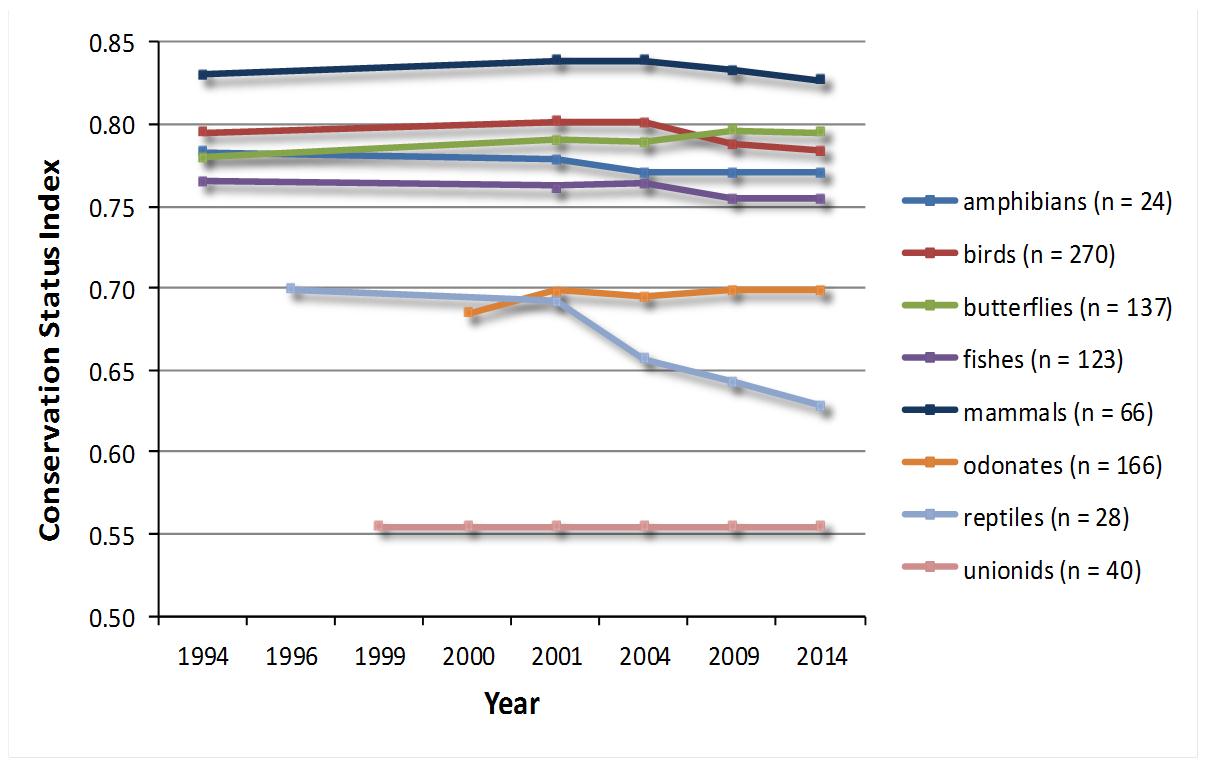Although many Ontario species are secure, others are at risk of disappearing from the province due to threats such as habitat loss, invasive species, pollution, unsustainable use and climate change (Ontario Biodiversity Council 2010). Determining which species and species groups are thriving and which are rare or declining is crucial in understanding the current state of biodiversity in Ontario and targeting conservation towards those elements of biodiversity in greatest need.
Provincial trends in conservation status ranks that reflect extinction risk can be used to provide an assessment of the changing state of regional biodiversity (Quayle et al. 2007). Trends in the Conservation Status Index were examined to complement the Species of Conservation Concern Indicator. Using historical sub-national Conservation Status Ranks (S-ranks) determined by the Ontario Natural Heritage Information Centre (NHIC), a Conservation Status Index was developed for five vertebrate groups (fishes, amphibians, reptiles, birds and mammals) and three invertebrate groups (Odonates – damselflies and dragonflies, butterflies and Unionids – freshwater mussels) in Ontario (Figure 1). For each taxon group assessed, the Conservation Status Index was calculated for five different time periods between 1994 and 2014. Conservation Status Index values were calculated following formulae presented in Buchart et al. (2007), where an index value of 1 indicates that all species in the group are secure and an index value of 0 indicates all species in the group are extirpated. It is important to note that to calculate the Conservation Status Index for each taxonomic group, genuine changes in status for each species were first differentiated from changes due to other factors (e.g., improved species knowledge, taxonomy or criteria changes). The S-ranks were then retrospectively corrected to reflect the actual status of the species.
The results of the assessment demonstrate that during the last decade the Conservation Status Index for fishes, amphibians, reptiles, birds and mammals has declined, with the largest observed decline for reptiles which dropped from 0.70 in 1996 to 0.63 in 2014. This is likely related to increasing habitat loss and fragmentation, which is the primary threat to reptiles in Ontario. The Conservation Status Index for freshwater mussels (unionids) was the lowest (0.5) of the groups assessed, but remained stable over the assessment period. This is likely related to the fact that many freshwater mussels have a limited range in Ontario and some are considered globally rare. Also, several species declined in the Great Lakes and connecting channels following the introduction of the Zebra Mussel in the late 1980s prior to initial ranking by NHIC. Finally, the Conservation Status Index for butterflies and odonates in Ontario increased during the last decade. This is related to a number of species whose range has expanded, perhaps as a result of climate change.
Figure 1. Conservation Status Index for eight taxonomic groups in Ontario 1994-2014.
References
Butchart, S. H. M., A. J. Stattersfield, L. A. Bennun, S. M. Shutes, H. R. Akakaya, J. E. M., Baillie, S. N. Stuart, C. Hilton-Taylor, and G. M. Mace. 2007. Measuring global trends in the status of biodiversity: Red List Indices for birds. PLoS Biol 2 (12): e383. [Available at: http://www.plosbiology.org/article/info:doi/10.1371/journal.pbio.0020383]
Ontario Biodiversity Council. 2010. State of Ontario’s biodiversity 2010. A Report of the Ontario Biodiversity Council, Peterborough, Ontario. [Available at: http://viewer.zmags.com/publication/6aa599ac#/6aa599ac/1]
Quayle, J.F., L.R. Ramsay and D.F. Fraser. 2007. Trend in the status of breeding bird fauna in British Columbia, Canada, based on the IUCN Red List Index method. Conservation Biology 21:1241-1247.

